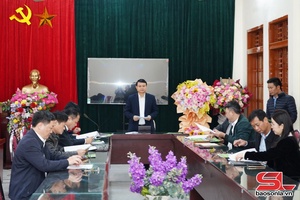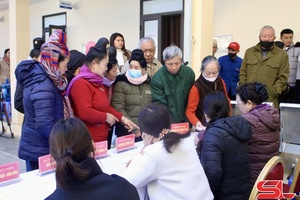
Youth union members of Muong Bu commune clean and tidy up local roads.
Achieving environmental criteria in new-style rural development largely depends on changing people’s habits and daily practices. Political and social organisations have played a key role in this effort, focusing on awareness-raising and building creative models suited to local realities. The provincial Vietnam Fatherland Front (VFF) Committee and its member organisations have effectively integrated environmental awareness campaigns into major events such as World Environment Day (June 5), Action Month for the Environment, Earth Hour, and the “Clean Up the World” campaign.
They have also launched movements like “All People Unite to Build New-Style Rural Areas and Civilised Urban Areas,” linked with environmental standards. Notable examples include the Women’s Union’s campaigns such as “5 No’s, 3 Cleans,” “Clean Houses, Beautiful Gardens,” and “Flower Roads”; and the Youth Union’s “Green Sundays” and “Volunteer Saturdays.” These organisations have mobilised members to help residents sort waste, build household garbage pits and sanitary latrines, relocate livestock pens, clean ditches, dredge irrigation canals, and implement various green initiatives that sustainably improve rural environmental quality.
According to Hoang Thi Luong Tam, Vice Chairwoman of the provincial VFF Committee, the committee’s Standing Board has directed and guided all levels and socio-political organisations to select appropriate models under the motto “Mobilising the people’s strength to care for the people’s lives,” achieving many notable results.
From 2021 to 2025, the Women’s Union has carried out 580 new rural projects, supported 42,293 households in meeting the “5 No’s, 3 Cleans” standards, maintained 78 plastic waste collection models, 152 waste classification models, and planted 840,859 new trees.
The Youth Union has implemented the “Lighting up Rural Roads” programme, covering over 100 km, and built and repaired 104 irrigation works and civil bridges.
The Veterans Association has mobilised members to donate 260,336 sq.m of land, over 27,400 trees, 28.2 billion VND (1.07 million USD), and 105,238 workdays for building roads, canals, and bridges.
The Farmers’ Union has contributed over 7.7 billion VND, 146,851 sq.m of land, and 59,136 workdays, helping transform the appearance of new-style rural areas.

Residents of Cat Linh hamlet, Muong La commune build sanitary toilets with financial support from the hamlet fund.
In addition, localities have mobilised both state and community resources to invest in environmental protection projects. Since 2021, more than 53 billion VND has been allocated to build and upgrade five centralised waste collection and treatment sites. Tens of thousands of household garbage pits, sanitary toilets, and clean water facilities have been constructed through socialised funding and policy loans. The province has also built over 5,500 pesticide container collection tanks and safely disposed of more than 155 tonnes of packaging waste, protecting soil and water resources.
Waste sorting at source, tree planting, flower-lined roads, and self-managed community streets have been effectively implemented at the grassroots level. As a result, rural environments have seen marked improvements, with over 50% of village roads and alleys upgraded; 70% of livestock farms having sanitary facilities; 100% of communes having designated cemeteries; 98% of the population using clean water; and 88% of household solid waste collected and treated. Hamlets now boast cleaner streets, greenery, lighting, and traffic signs. Many model new rural areas focusing on environmental protection and rural tourism have emerged and been replicated.
Before the operation to the two-tier local government model, the province had already achieved environmental and food safety criteria in 90 communes.
Hang A Su, Secretary of the Party cell and head of Cat Linh hamlet, Muong La commune, shared: “Our village is oriented toward eco-tourism, so we always prioritise environmental sanitation. Using the Forest Environmental Service Fund, we supported nearly 150 million VND to build 43 sanitary toilets and 53 mini garbage pits, enabling households to manage waste locally while protecting the environment and promoting sustainable tourism.”
Building new-style rural areas is a continuous process that requires maintaining and improving all criteria, especially environmental standards, which depend on community participation. By mobilising investment resources, strengthening management of facilities, and strictly handling pollution violations, localities are contributing to environmental protection and improving the quality of life for rural residents.






(1).jpg)
















You have 500/500 characters left
Please enter 5 or more characters!!!